The Impact of Smartphone Use on Work-Life Balance: An Analysis
VerifiedAdded on 2021/04/19
|7
|1706
|354
Essay
AI Summary
This essay delves into the intricate relationship between work-life balance and smartphone usage, exploring both the advantages and disadvantages of this technology. It defines work-life balance and work-life conflict, highlighting the potential for smartphone addiction to negatively impact mental health and even contribute to accidents. The essay presents arguments both in favor of and against smartphone use, citing research on flexible working hours, improved job performance, and enhanced collaboration. However, it also acknowledges the blurring of boundaries between work and personal life, the intrusion of work-related emails, and the potential for increased stress. The essay concludes that a balanced approach to smartphone use is essential to maximize its benefits while mitigating its negative effects. This analysis provides valuable insights into managing the impact of technology on personal and professional well-being.

Running head: WORK-LIFE BALANCE AND USE OF SMARTPHONE
Work-life Balance and use of Smartphone
Name of the Student
Name of the University
Author Note
Work-life Balance and use of Smartphone
Name of the Student
Name of the University
Author Note
Paraphrase This Document
Need a fresh take? Get an instant paraphrase of this document with our AI Paraphraser
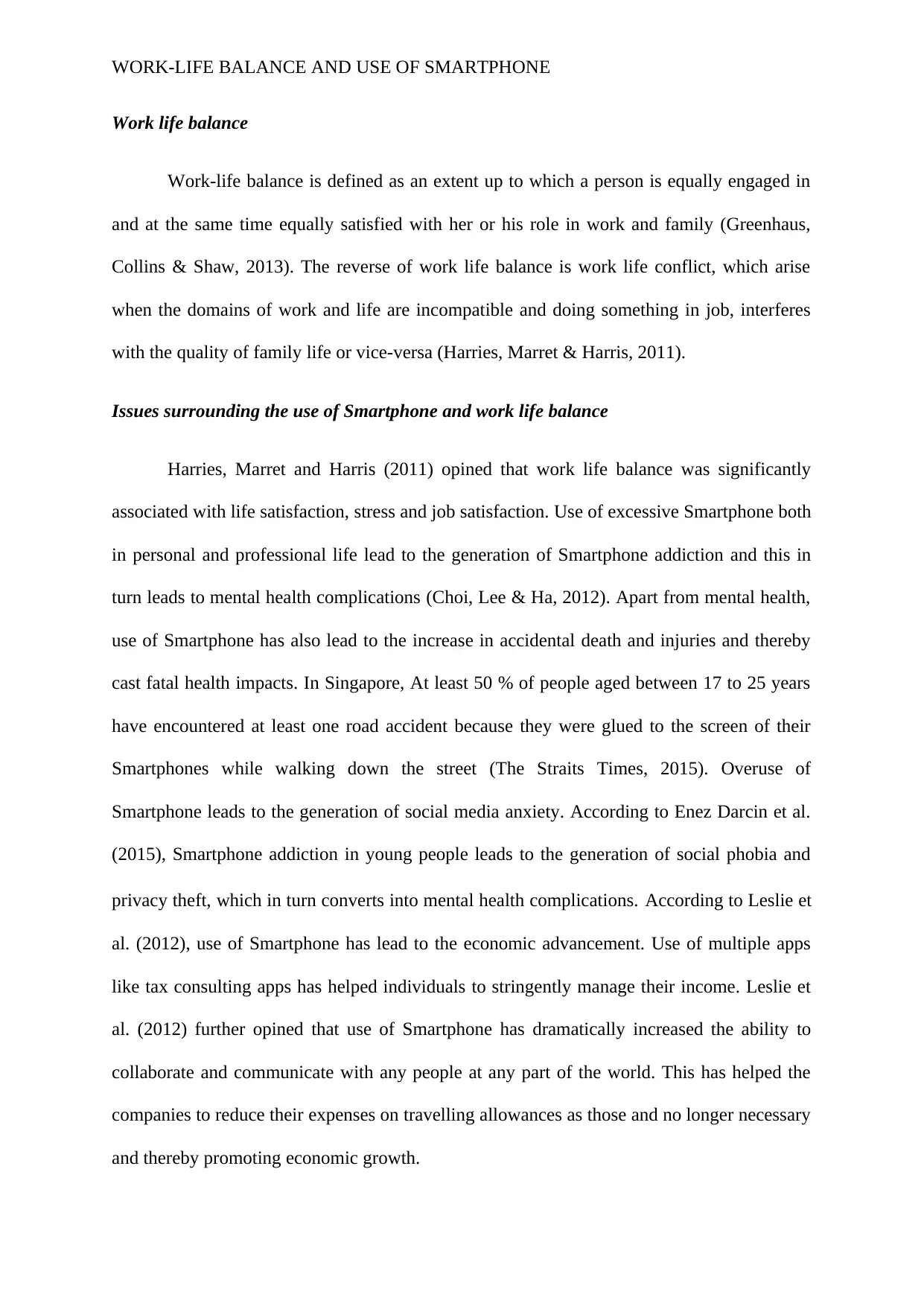
WORK-LIFE BALANCE AND USE OF SMARTPHONE
Work life balance
Work-life balance is defined as an extent up to which a person is equally engaged in
and at the same time equally satisfied with her or his role in work and family (Greenhaus,
Collins & Shaw, 2013). The reverse of work life balance is work life conflict, which arise
when the domains of work and life are incompatible and doing something in job, interferes
with the quality of family life or vice-versa (Harries, Marret & Harris, 2011).
Issues surrounding the use of Smartphone and work life balance
Harries, Marret and Harris (2011) opined that work life balance was significantly
associated with life satisfaction, stress and job satisfaction. Use of excessive Smartphone both
in personal and professional life lead to the generation of Smartphone addiction and this in
turn leads to mental health complications (Choi, Lee & Ha, 2012). Apart from mental health,
use of Smartphone has also lead to the increase in accidental death and injuries and thereby
cast fatal health impacts. In Singapore, At least 50 % of people aged between 17 to 25 years
have encountered at least one road accident because they were glued to the screen of their
Smartphones while walking down the street (The Straits Times, 2015). Overuse of
Smartphone leads to the generation of social media anxiety. According to Enez Darcin et al.
(2015), Smartphone addiction in young people leads to the generation of social phobia and
privacy theft, which in turn converts into mental health complications. According to Leslie et
al. (2012), use of Smartphone has lead to the economic advancement. Use of multiple apps
like tax consulting apps has helped individuals to stringently manage their income. Leslie et
al. (2012) further opined that use of Smartphone has dramatically increased the ability to
collaborate and communicate with any people at any part of the world. This has helped the
companies to reduce their expenses on travelling allowances as those and no longer necessary
and thereby promoting economic growth.
Work life balance
Work-life balance is defined as an extent up to which a person is equally engaged in
and at the same time equally satisfied with her or his role in work and family (Greenhaus,
Collins & Shaw, 2013). The reverse of work life balance is work life conflict, which arise
when the domains of work and life are incompatible and doing something in job, interferes
with the quality of family life or vice-versa (Harries, Marret & Harris, 2011).
Issues surrounding the use of Smartphone and work life balance
Harries, Marret and Harris (2011) opined that work life balance was significantly
associated with life satisfaction, stress and job satisfaction. Use of excessive Smartphone both
in personal and professional life lead to the generation of Smartphone addiction and this in
turn leads to mental health complications (Choi, Lee & Ha, 2012). Apart from mental health,
use of Smartphone has also lead to the increase in accidental death and injuries and thereby
cast fatal health impacts. In Singapore, At least 50 % of people aged between 17 to 25 years
have encountered at least one road accident because they were glued to the screen of their
Smartphones while walking down the street (The Straits Times, 2015). Overuse of
Smartphone leads to the generation of social media anxiety. According to Enez Darcin et al.
(2015), Smartphone addiction in young people leads to the generation of social phobia and
privacy theft, which in turn converts into mental health complications. According to Leslie et
al. (2012), use of Smartphone has lead to the economic advancement. Use of multiple apps
like tax consulting apps has helped individuals to stringently manage their income. Leslie et
al. (2012) further opined that use of Smartphone has dramatically increased the ability to
collaborate and communicate with any people at any part of the world. This has helped the
companies to reduce their expenses on travelling allowances as those and no longer necessary
and thereby promoting economic growth.
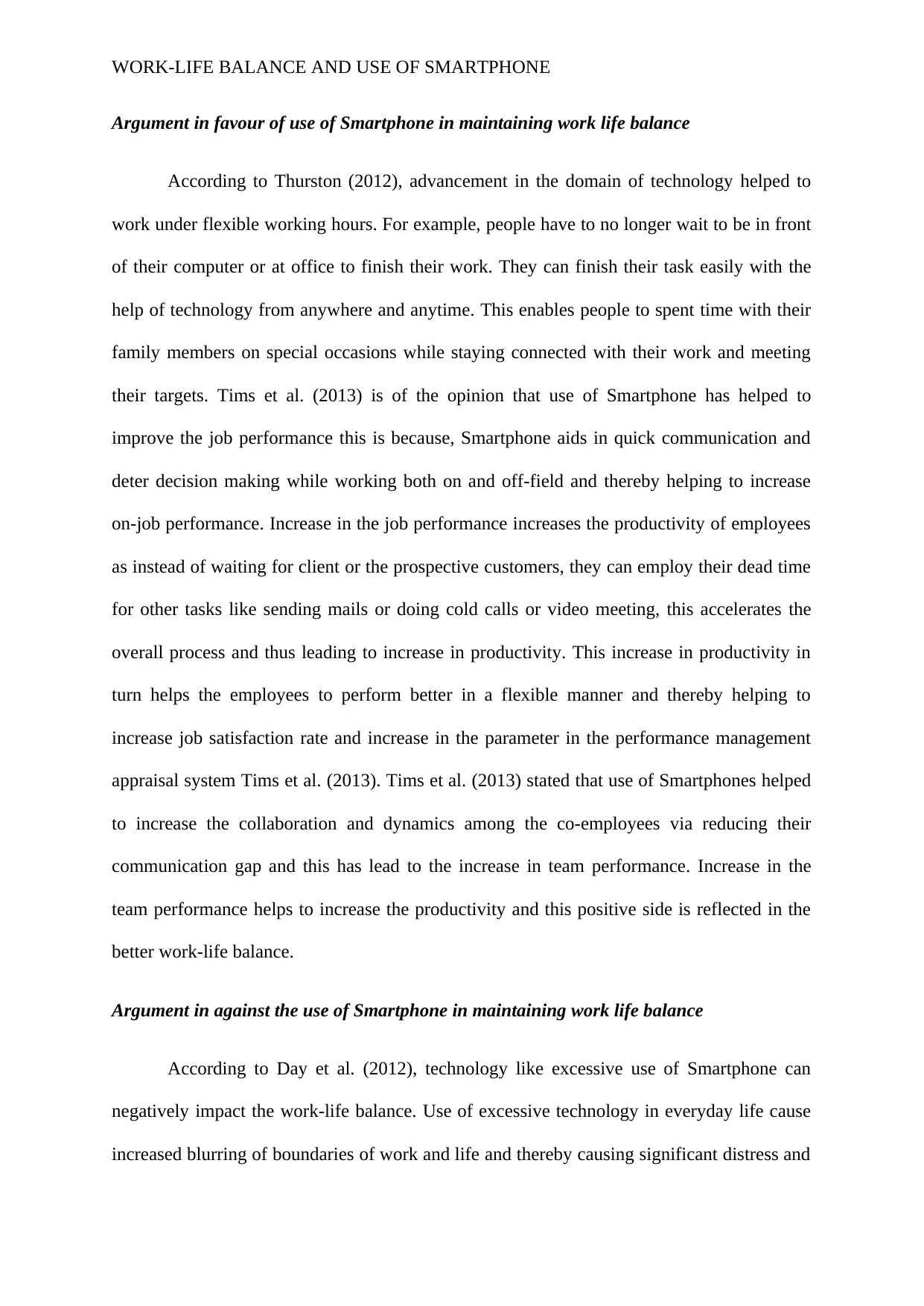
WORK-LIFE BALANCE AND USE OF SMARTPHONE
Argument in favour of use of Smartphone in maintaining work life balance
According to Thurston (2012), advancement in the domain of technology helped to
work under flexible working hours. For example, people have to no longer wait to be in front
of their computer or at office to finish their work. They can finish their task easily with the
help of technology from anywhere and anytime. This enables people to spent time with their
family members on special occasions while staying connected with their work and meeting
their targets. Tims et al. (2013) is of the opinion that use of Smartphone has helped to
improve the job performance this is because, Smartphone aids in quick communication and
deter decision making while working both on and off-field and thereby helping to increase
on-job performance. Increase in the job performance increases the productivity of employees
as instead of waiting for client or the prospective customers, they can employ their dead time
for other tasks like sending mails or doing cold calls or video meeting, this accelerates the
overall process and thus leading to increase in productivity. This increase in productivity in
turn helps the employees to perform better in a flexible manner and thereby helping to
increase job satisfaction rate and increase in the parameter in the performance management
appraisal system Tims et al. (2013). Tims et al. (2013) stated that use of Smartphones helped
to increase the collaboration and dynamics among the co-employees via reducing their
communication gap and this has lead to the increase in team performance. Increase in the
team performance helps to increase the productivity and this positive side is reflected in the
better work-life balance.
Argument in against the use of Smartphone in maintaining work life balance
According to Day et al. (2012), technology like excessive use of Smartphone can
negatively impact the work-life balance. Use of excessive technology in everyday life cause
increased blurring of boundaries of work and life and thereby causing significant distress and
Argument in favour of use of Smartphone in maintaining work life balance
According to Thurston (2012), advancement in the domain of technology helped to
work under flexible working hours. For example, people have to no longer wait to be in front
of their computer or at office to finish their work. They can finish their task easily with the
help of technology from anywhere and anytime. This enables people to spent time with their
family members on special occasions while staying connected with their work and meeting
their targets. Tims et al. (2013) is of the opinion that use of Smartphone has helped to
improve the job performance this is because, Smartphone aids in quick communication and
deter decision making while working both on and off-field and thereby helping to increase
on-job performance. Increase in the job performance increases the productivity of employees
as instead of waiting for client or the prospective customers, they can employ their dead time
for other tasks like sending mails or doing cold calls or video meeting, this accelerates the
overall process and thus leading to increase in productivity. This increase in productivity in
turn helps the employees to perform better in a flexible manner and thereby helping to
increase job satisfaction rate and increase in the parameter in the performance management
appraisal system Tims et al. (2013). Tims et al. (2013) stated that use of Smartphones helped
to increase the collaboration and dynamics among the co-employees via reducing their
communication gap and this has lead to the increase in team performance. Increase in the
team performance helps to increase the productivity and this positive side is reflected in the
better work-life balance.
Argument in against the use of Smartphone in maintaining work life balance
According to Day et al. (2012), technology like excessive use of Smartphone can
negatively impact the work-life balance. Use of excessive technology in everyday life cause
increased blurring of boundaries of work and life and thereby causing significant distress and
⊘ This is a preview!⊘
Do you want full access?
Subscribe today to unlock all pages.

Trusted by 1+ million students worldwide
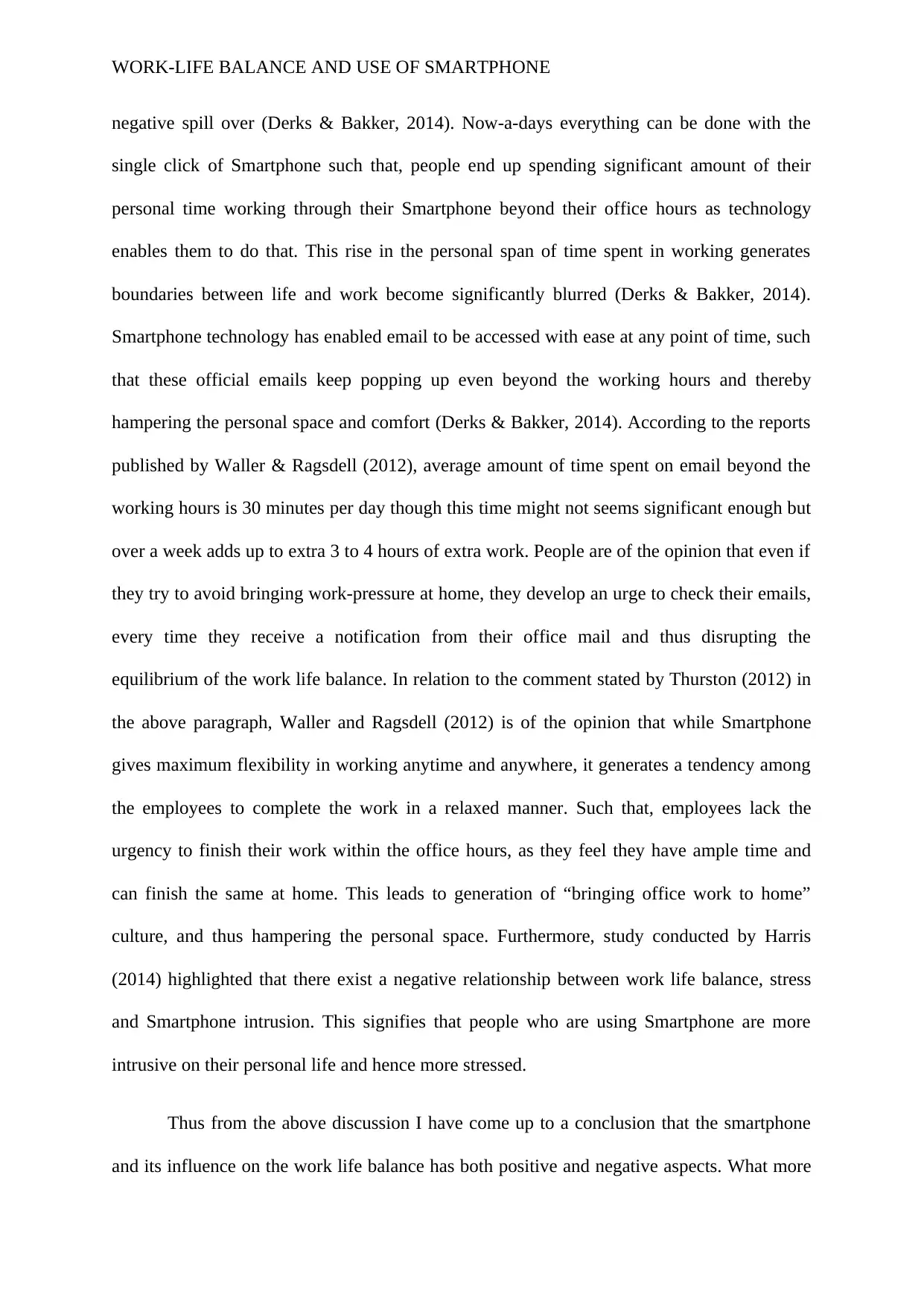
WORK-LIFE BALANCE AND USE OF SMARTPHONE
negative spill over (Derks & Bakker, 2014). Now-a-days everything can be done with the
single click of Smartphone such that, people end up spending significant amount of their
personal time working through their Smartphone beyond their office hours as technology
enables them to do that. This rise in the personal span of time spent in working generates
boundaries between life and work become significantly blurred (Derks & Bakker, 2014).
Smartphone technology has enabled email to be accessed with ease at any point of time, such
that these official emails keep popping up even beyond the working hours and thereby
hampering the personal space and comfort (Derks & Bakker, 2014). According to the reports
published by Waller & Ragsdell (2012), average amount of time spent on email beyond the
working hours is 30 minutes per day though this time might not seems significant enough but
over a week adds up to extra 3 to 4 hours of extra work. People are of the opinion that even if
they try to avoid bringing work-pressure at home, they develop an urge to check their emails,
every time they receive a notification from their office mail and thus disrupting the
equilibrium of the work life balance. In relation to the comment stated by Thurston (2012) in
the above paragraph, Waller and Ragsdell (2012) is of the opinion that while Smartphone
gives maximum flexibility in working anytime and anywhere, it generates a tendency among
the employees to complete the work in a relaxed manner. Such that, employees lack the
urgency to finish their work within the office hours, as they feel they have ample time and
can finish the same at home. This leads to generation of “bringing office work to home”
culture, and thus hampering the personal space. Furthermore, study conducted by Harris
(2014) highlighted that there exist a negative relationship between work life balance, stress
and Smartphone intrusion. This signifies that people who are using Smartphone are more
intrusive on their personal life and hence more stressed.
Thus from the above discussion I have come up to a conclusion that the smartphone
and its influence on the work life balance has both positive and negative aspects. What more
negative spill over (Derks & Bakker, 2014). Now-a-days everything can be done with the
single click of Smartphone such that, people end up spending significant amount of their
personal time working through their Smartphone beyond their office hours as technology
enables them to do that. This rise in the personal span of time spent in working generates
boundaries between life and work become significantly blurred (Derks & Bakker, 2014).
Smartphone technology has enabled email to be accessed with ease at any point of time, such
that these official emails keep popping up even beyond the working hours and thereby
hampering the personal space and comfort (Derks & Bakker, 2014). According to the reports
published by Waller & Ragsdell (2012), average amount of time spent on email beyond the
working hours is 30 minutes per day though this time might not seems significant enough but
over a week adds up to extra 3 to 4 hours of extra work. People are of the opinion that even if
they try to avoid bringing work-pressure at home, they develop an urge to check their emails,
every time they receive a notification from their office mail and thus disrupting the
equilibrium of the work life balance. In relation to the comment stated by Thurston (2012) in
the above paragraph, Waller and Ragsdell (2012) is of the opinion that while Smartphone
gives maximum flexibility in working anytime and anywhere, it generates a tendency among
the employees to complete the work in a relaxed manner. Such that, employees lack the
urgency to finish their work within the office hours, as they feel they have ample time and
can finish the same at home. This leads to generation of “bringing office work to home”
culture, and thus hampering the personal space. Furthermore, study conducted by Harris
(2014) highlighted that there exist a negative relationship between work life balance, stress
and Smartphone intrusion. This signifies that people who are using Smartphone are more
intrusive on their personal life and hence more stressed.
Thus from the above discussion I have come up to a conclusion that the smartphone
and its influence on the work life balance has both positive and negative aspects. What more
Paraphrase This Document
Need a fresh take? Get an instant paraphrase of this document with our AI Paraphraser
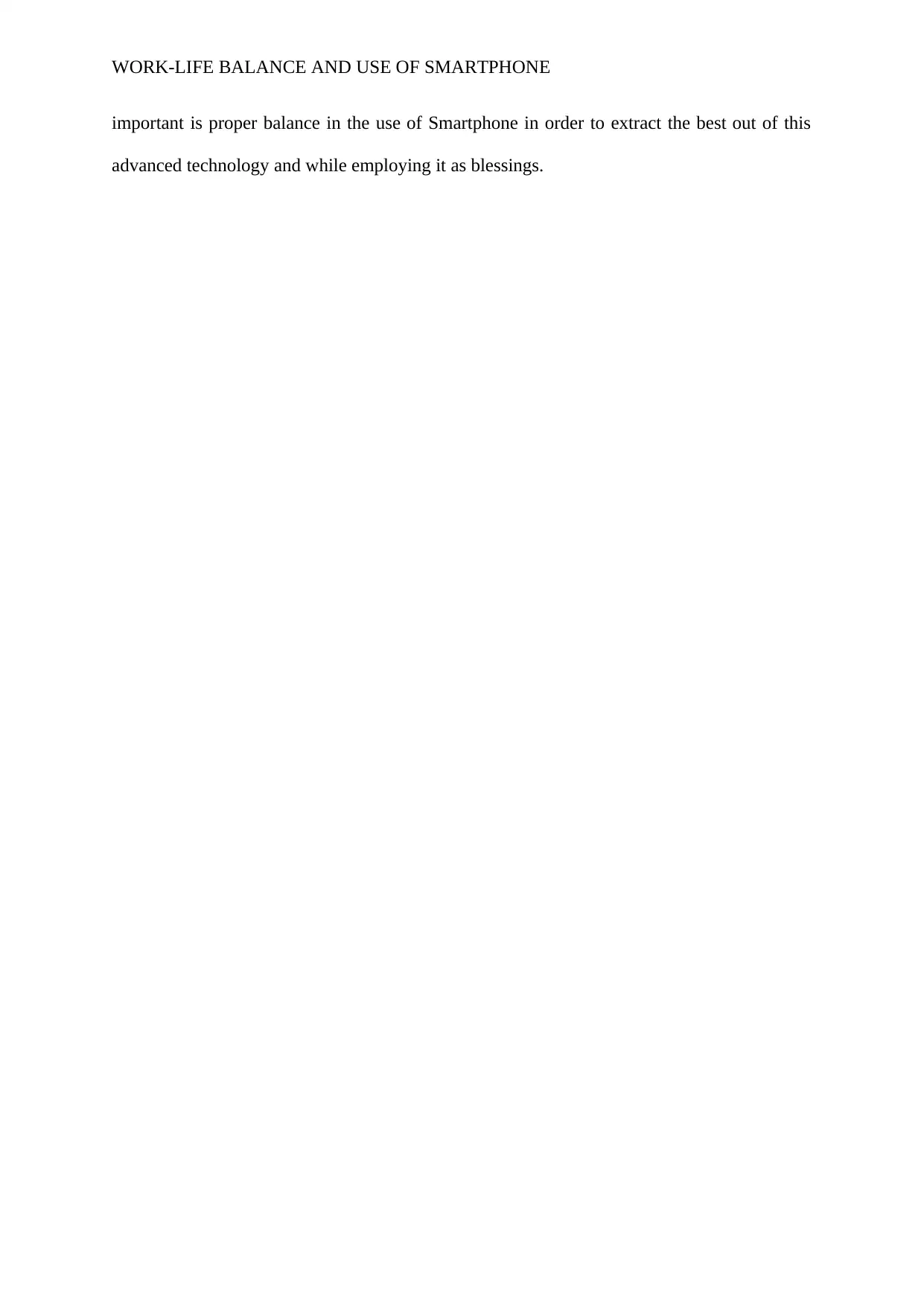
WORK-LIFE BALANCE AND USE OF SMARTPHONE
important is proper balance in the use of Smartphone in order to extract the best out of this
advanced technology and while employing it as blessings.
important is proper balance in the use of Smartphone in order to extract the best out of this
advanced technology and while employing it as blessings.
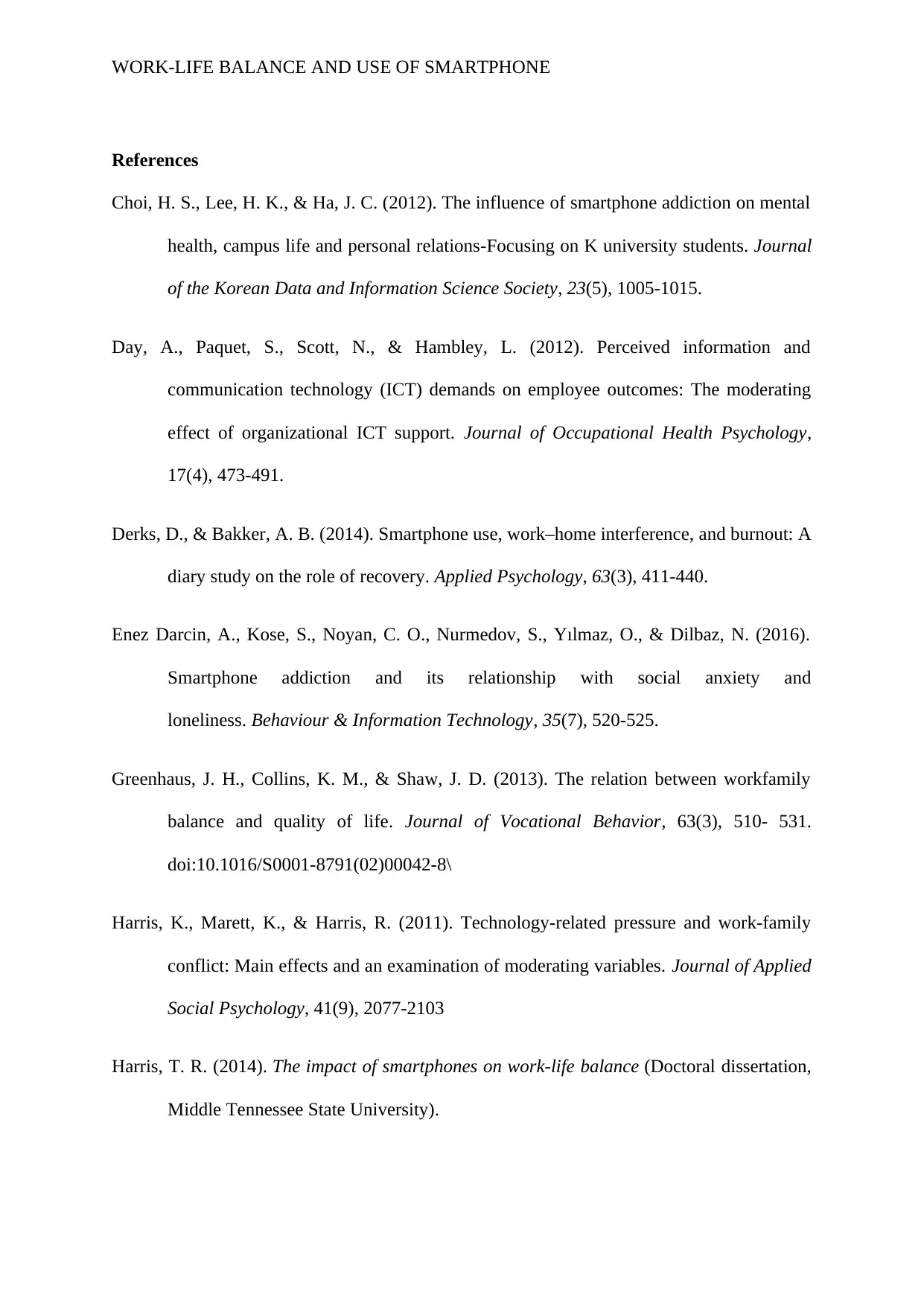
WORK-LIFE BALANCE AND USE OF SMARTPHONE
References
Choi, H. S., Lee, H. K., & Ha, J. C. (2012). The influence of smartphone addiction on mental
health, campus life and personal relations-Focusing on K university students. Journal
of the Korean Data and Information Science Society, 23(5), 1005-1015.
Day, A., Paquet, S., Scott, N., & Hambley, L. (2012). Perceived information and
communication technology (ICT) demands on employee outcomes: The moderating
effect of organizational ICT support. Journal of Occupational Health Psychology,
17(4), 473-491.
Derks, D., & Bakker, A. B. (2014). Smartphone use, work–home interference, and burnout: A
diary study on the role of recovery. Applied Psychology, 63(3), 411-440.
Enez Darcin, A., Kose, S., Noyan, C. O., Nurmedov, S., Yılmaz, O., & Dilbaz, N. (2016).
Smartphone addiction and its relationship with social anxiety and
loneliness. Behaviour & Information Technology, 35(7), 520-525.
Greenhaus, J. H., Collins, K. M., & Shaw, J. D. (2013). The relation between workfamily
balance and quality of life. Journal of Vocational Behavior, 63(3), 510- 531.
doi:10.1016/S0001-8791(02)00042-8\
Harris, K., Marett, K., & Harris, R. (2011). Technology-related pressure and work-family
conflict: Main effects and an examination of moderating variables. Journal of Applied
Social Psychology, 41(9), 2077-2103
Harris, T. R. (2014). The impact of smartphones on work-life balance (Doctoral dissertation,
Middle Tennessee State University).
References
Choi, H. S., Lee, H. K., & Ha, J. C. (2012). The influence of smartphone addiction on mental
health, campus life and personal relations-Focusing on K university students. Journal
of the Korean Data and Information Science Society, 23(5), 1005-1015.
Day, A., Paquet, S., Scott, N., & Hambley, L. (2012). Perceived information and
communication technology (ICT) demands on employee outcomes: The moderating
effect of organizational ICT support. Journal of Occupational Health Psychology,
17(4), 473-491.
Derks, D., & Bakker, A. B. (2014). Smartphone use, work–home interference, and burnout: A
diary study on the role of recovery. Applied Psychology, 63(3), 411-440.
Enez Darcin, A., Kose, S., Noyan, C. O., Nurmedov, S., Yılmaz, O., & Dilbaz, N. (2016).
Smartphone addiction and its relationship with social anxiety and
loneliness. Behaviour & Information Technology, 35(7), 520-525.
Greenhaus, J. H., Collins, K. M., & Shaw, J. D. (2013). The relation between workfamily
balance and quality of life. Journal of Vocational Behavior, 63(3), 510- 531.
doi:10.1016/S0001-8791(02)00042-8\
Harris, K., Marett, K., & Harris, R. (2011). Technology-related pressure and work-family
conflict: Main effects and an examination of moderating variables. Journal of Applied
Social Psychology, 41(9), 2077-2103
Harris, T. R. (2014). The impact of smartphones on work-life balance (Doctoral dissertation,
Middle Tennessee State University).
⊘ This is a preview!⊘
Do you want full access?
Subscribe today to unlock all pages.

Trusted by 1+ million students worldwide
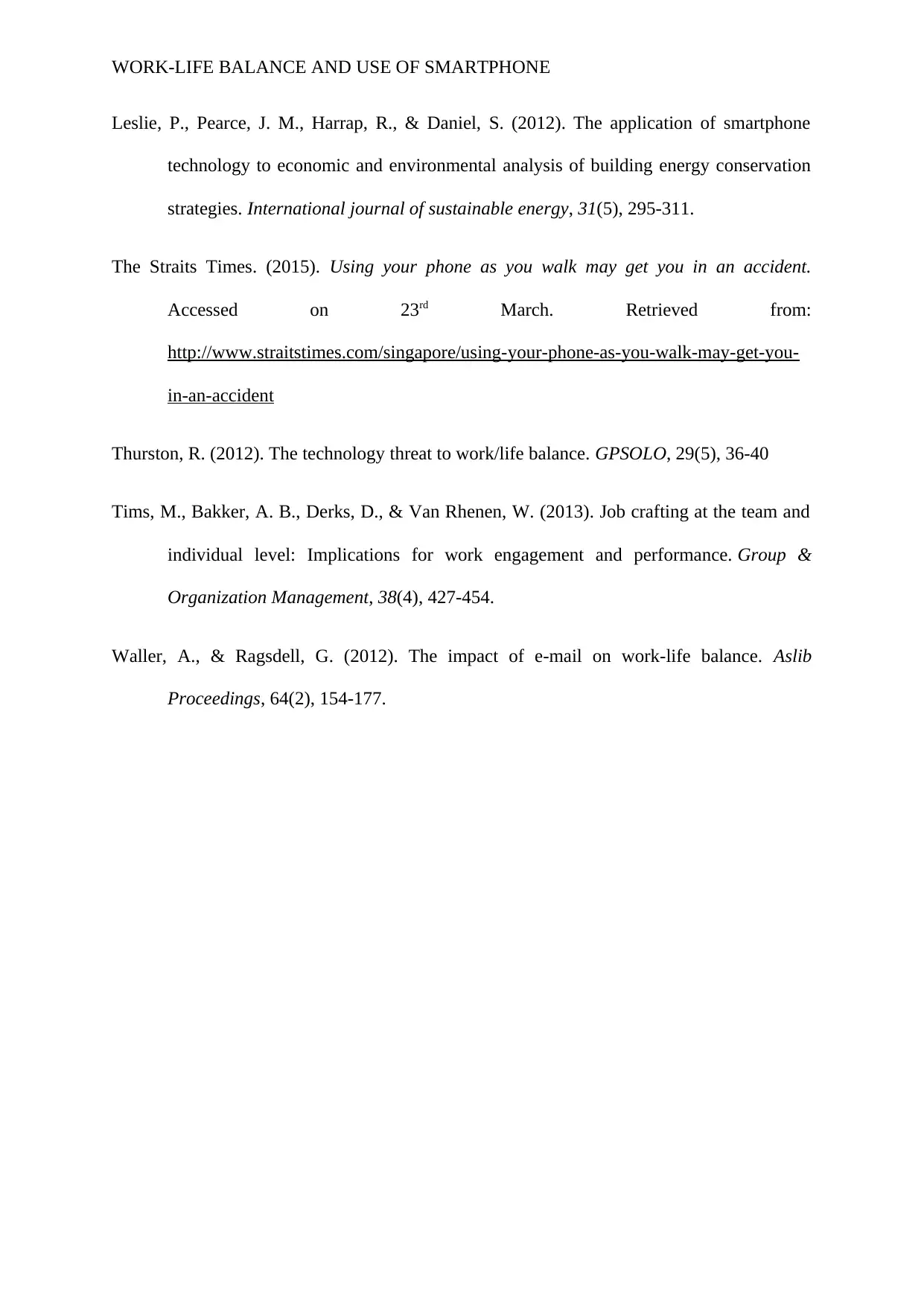
WORK-LIFE BALANCE AND USE OF SMARTPHONE
Leslie, P., Pearce, J. M., Harrap, R., & Daniel, S. (2012). The application of smartphone
technology to economic and environmental analysis of building energy conservation
strategies. International journal of sustainable energy, 31(5), 295-311.
The Straits Times. (2015). Using your phone as you walk may get you in an accident.
Accessed on 23rd March. Retrieved from:
http://www.straitstimes.com/singapore/using-your-phone-as-you-walk-may-get-you-
in-an-accident
Thurston, R. (2012). The technology threat to work/life balance. GPSOLO, 29(5), 36-40
Tims, M., Bakker, A. B., Derks, D., & Van Rhenen, W. (2013). Job crafting at the team and
individual level: Implications for work engagement and performance. Group &
Organization Management, 38(4), 427-454.
Waller, A., & Ragsdell, G. (2012). The impact of e-mail on work-life balance. Aslib
Proceedings, 64(2), 154-177.
Leslie, P., Pearce, J. M., Harrap, R., & Daniel, S. (2012). The application of smartphone
technology to economic and environmental analysis of building energy conservation
strategies. International journal of sustainable energy, 31(5), 295-311.
The Straits Times. (2015). Using your phone as you walk may get you in an accident.
Accessed on 23rd March. Retrieved from:
http://www.straitstimes.com/singapore/using-your-phone-as-you-walk-may-get-you-
in-an-accident
Thurston, R. (2012). The technology threat to work/life balance. GPSOLO, 29(5), 36-40
Tims, M., Bakker, A. B., Derks, D., & Van Rhenen, W. (2013). Job crafting at the team and
individual level: Implications for work engagement and performance. Group &
Organization Management, 38(4), 427-454.
Waller, A., & Ragsdell, G. (2012). The impact of e-mail on work-life balance. Aslib
Proceedings, 64(2), 154-177.
1 out of 7
Related Documents
Your All-in-One AI-Powered Toolkit for Academic Success.
+13062052269
info@desklib.com
Available 24*7 on WhatsApp / Email
![[object Object]](/_next/static/media/star-bottom.7253800d.svg)
Unlock your academic potential
Copyright © 2020–2025 A2Z Services. All Rights Reserved. Developed and managed by ZUCOL.





